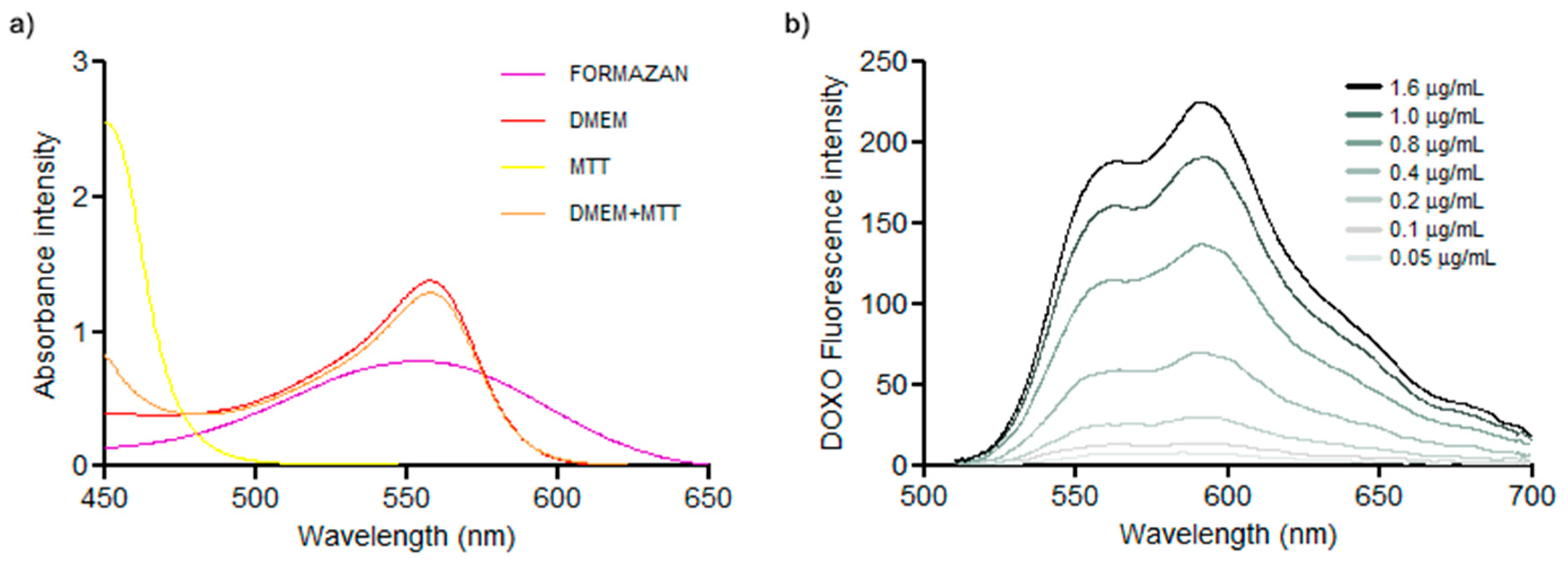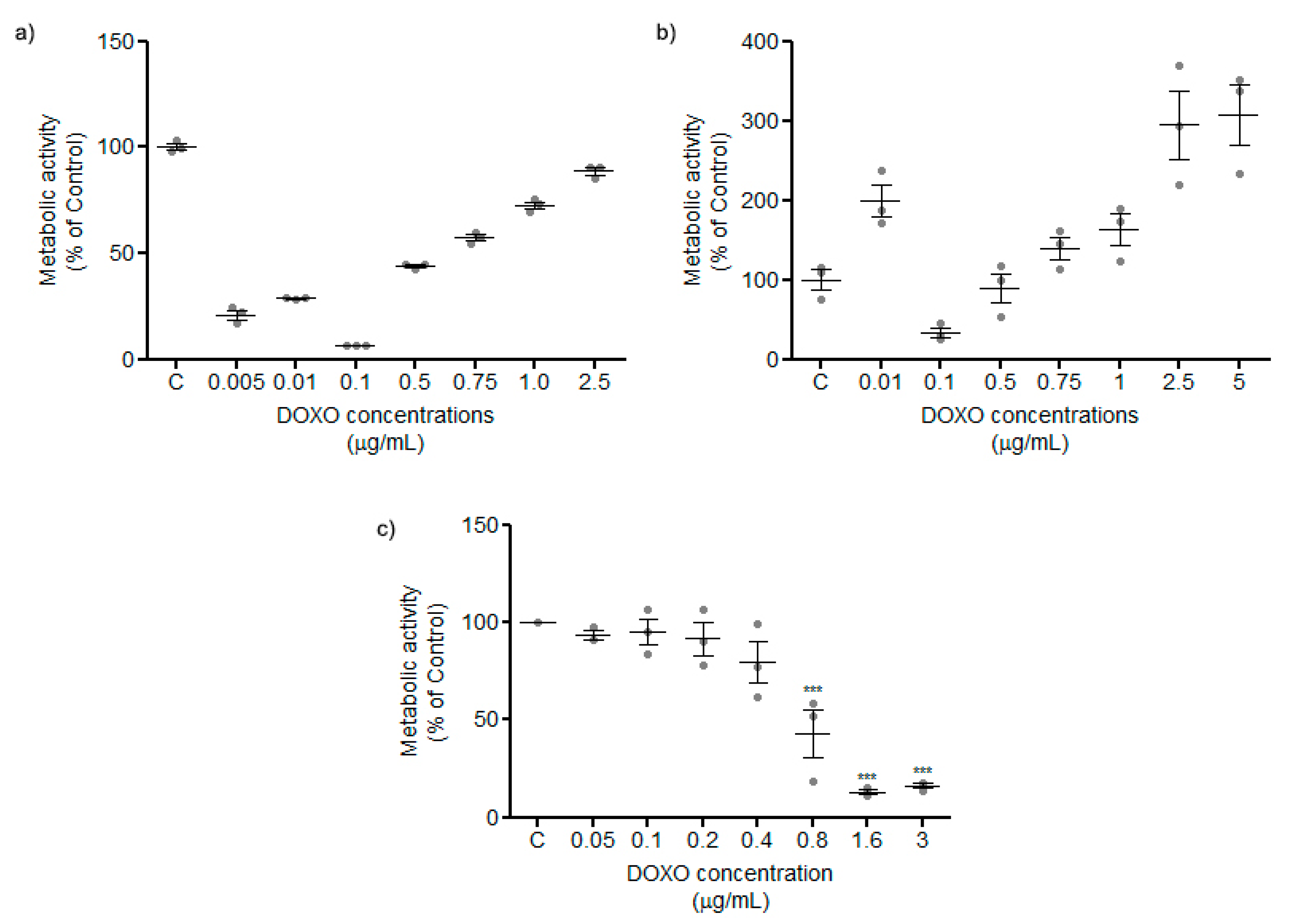Avoiding the Interference of Doxorubicin with MTT Measurements on the MCF-7 Breast Cancer Cell Line
Abstract
:1. Introduction
2. Materials and Methods
2.1. Materials
2.1.1. Chemicals
2.1.2. Cells
2.1.3. Equipment
2.2. Methods
2.2.1. Absorbance Spectra
2.2.2. Intrinsic Emission Fluorescence by Fluorescence Spectrometry
2.2.3. Dose-Response Curve Based on MTT
3. Results
3.1. Absorbance Spectra
3.2. Dose-Response Curve Based on MTT
4. Discussion and Conclusions
Author Contributions
Funding
Conflicts of Interest
References
- Peters, W.P.; Ross, M.; Vredenburgh, J.J.; Meisenberg, B.; Marks, L.B.; Winer, E.; Kurtzberg, J.; Bast, R.C., Jr.; Jones, R.; Shpall, E. High-dose chemotherapy and autologous bone marrow support as consolidation after standard-dose adjuvant therapy for high-risk primary breast cancer. J. Clin. Oncol. 1993, 11, 1132–1143. [Google Scholar] [CrossRef] [PubMed]
- Goodnow, R.A.; Davie, C.P. DNA-Encoded Library Technology: A Brief Guide to Its Evolution and Impact on Drug Discovery. Annu. Rep. Med. Chem. 2017, 50, 1–15. [Google Scholar] [CrossRef]
- Mosmann, T. Rapid colorimetric assay for cellular growth and survival: Application to proliferation and cytotoxicity assays. J. Immunol. Methods 1983, 65, 55–63. [Google Scholar] [CrossRef]
- Berridge, M.V.; Herst, P.M.; Tan, A.S. Tetrazolium dyes as tools in cell biology: New insights into their cellular reduction. Biotechnol. Annu. Rev. 2005, 11, 127–152. [Google Scholar] [CrossRef] [PubMed]
- Twentyman, P.R.; Luscombe, M. A study of some variables in a tetrazolium dye (MTT) based assay for cell growth and chemosensitivity. Br. J. Cancer 1987, 56, 279. [Google Scholar] [CrossRef] [PubMed]
- Riss, T. Is Your MTT Assay Really the Best Choice? Promega Corp. 2014. [Google Scholar] [CrossRef]


© 2019 by the authors. Licensee MDPI, Basel, Switzerland. This article is an open access article distributed under the terms and conditions of the Creative Commons Attribution (CC BY) license (http://creativecommons.org/licenses/by/4.0/).
Share and Cite
Luis, C.; Castaño-Guerrero, Y.; Soares, R.; Sales, G.; Fernandes, R. Avoiding the Interference of Doxorubicin with MTT Measurements on the MCF-7 Breast Cancer Cell Line. Methods Protoc. 2019, 2, 29. https://doi.org/10.3390/mps2020029
Luis C, Castaño-Guerrero Y, Soares R, Sales G, Fernandes R. Avoiding the Interference of Doxorubicin with MTT Measurements on the MCF-7 Breast Cancer Cell Line. Methods and Protocols. 2019; 2(2):29. https://doi.org/10.3390/mps2020029
Chicago/Turabian StyleLuis, Carla, Yuselis Castaño-Guerrero, Raquel Soares, Goreti Sales, and Rúben Fernandes. 2019. "Avoiding the Interference of Doxorubicin with MTT Measurements on the MCF-7 Breast Cancer Cell Line" Methods and Protocols 2, no. 2: 29. https://doi.org/10.3390/mps2020029







